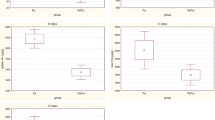Summary
The effects of different nickel chloride doses upon blood and plasma glucose and essential metal homeostasis were studied in male and female rats. A definite sex-dependent response to injections of nickel has been observed for both the increase in plasma and blood glucose levels and the time at which these levels peak. Males showed a fast recovery from the rise in glucose levels and were much less affected by changes in the other parameters studied. In females, an extended rise in glucose levels was observed. All these effects are clearly nickel dose-dependent. Plasma, liver and kidney copper levels rose significantly in females while only a small decrease was observed in male kidneys. Zinc levels rose in all organs studied but males recovered to basal levels after the study period, whereas females maintained maximum levels at the end of the same period. An increase in urinary excretion of iron was observed. The present results show that the sex differences to acute nickel toxicity can be a helpful way to study metal interaction and discriminate between specific toxicity due to nickel or that induced by the associated hyperglucagonemia.
Similar content being viewed by others
References
Barta-Bedö M, Gaal O (1977) Sexual differences in the caffeine and glucose tolerance in different rat strains. Nutr Metab 21:182–186
Bordas F, Papilion W, Nagy S (1980) Nickel- sowie Nickel- und Kadmium-induzierte Myocard-Veränderungen. In:3-Spurenelement Symposium: Nickel. K. Marx Universität, Leipzig and F. Schiller Universität, Jena, p 321
Bracken WM, Klaassen CD (1987) Induction of metallothionein by steroids in rat primary hepatocyte cultures. Toxicol Appl Pharmacol 87:381–388
Clary JJ (1975) Nickel-chloride-induced metabolic changes in the rat and guinea-pig. Toxicol Appl Pharmacol 31:55–65
Clemons G, Garcia J (1973) Neuroendocrine effects of acute nickel chloride administration in rats. Toxicol Appl Pharmacol 25:343–348
Etzel KR, Cousins RJ (1981) Hormonal regulation of liver metallothionein zinc: independent and synergistic action of glucagon and glucocorticoids. Proc Soc Exp Biol Med 167:233–236
Glennon JN, Sarkar B (1982) Nickel(II) transport in human blood serum. Biochem J 203:15–23
Hamer DH (1986) Metallothionein. Annu Rev Biochem 55:913–951
Horak E, Sunderman FW Jr (1975a) Effects of Ni(II) and other divalent metal ions and glucagon upon plasma glucose concentrations in normal, adrenalectomized and hypophysectomized rats. Toxicol Appl Pharmacol 32:316–329
Horak E, Sunderman FW Jr (1975b) Effects of Ni(II) upon plasma glucagon and glucose in rats. Toxicol Appl Pharmacol 33:388–391
Horak E, Zygowicz ER, Tarabishy R, Mitchell JM, Sunderman FW Jr (1978) Effect of nickel chloride and nickel carbonyl upon glucose metabolism in rats. Ann Clin Lab Sci 8:476–482
Kadota I, Kurita M (1955) Hyperglycemia and islet cell damage caused by nickel(II) chloride. Metabolism 4:337–342
Kirchgessner M, Schwartz FJ, Schnegg HA (1982) Interactions of essential metals in human physiology. In: Prasad AS (ed) Clinical, biochemical and nutritional aspects of trace elements. Alan R. Liss. New York, p 477
Kuipers PJ, Cousins RJ (1984) Zinc accumulation in rat liver parenquimal cells in primary culture and response to glucagon and dexamethasone. Fed Proc 43:1403
Lehman-McKeeman LD, Klaassen CD (1987) Induction of metallothionein-I and metallothionein-II in rats by cadmium and zinc. Toxicol Appl Pharmacol 88:195–202
Lowry OH, Rosebrough NJ, Farr AL, Randall RJ (1951) Protein measurement with the folin phenol reagent. J Biol Chem 193:265–275
Mas A, Holt D, Webb M (1985a) The acute toxicity and teratogenicity of nickel in pregnant rats. Toxicology 35:47–57
Mas A, Romeu A, Alemany M, Arola Ll (1985b) Iron, zinc and copper content in the tissues of the rat during pregnancy. Biol Trace Elem Res 8:105–111
Mas A, Alemany M, Arola Ll (1986a) Effects of a nickel load upon the concentration of plasma metabolites in pregnant rats. Gynecol Obstet Invest 21:193–197
Mas A, Peligero MJ, Alemany M, Arola Ll (1986b) Effect of an acute injection of nickel upon essential metal homeostasis in the rat: influence of sex and pregnancy. Biol Res Pregnancy 7:66–70
Mas A, Peligero MJ, Arola Ll, Alemany M (1986c) Distribution and kinetics of nickel in the pregnant rat. Clin Exp Pharmacol Physiol 13:91–96
McGarry JD, Foster DW (1980) Regulation of hepatic fatty acid oxidation and ketone body production. Annu Rev Biochem 49:395–420
Nielsen FH (1980) Interactions of nickel with essential minerals. In: Nriagu JO (ed) Nickel in the environment. Wiley-Interscience, New York, p 611
Nielsen FH, Zimmerman TJ, Collings ME, Myron DR (1979) Nickel deprivation in rats: nickel-iron interactions. J Nutr 109:1623–1632
Nielsen FH, Zimmerman TJ, Schuller TR (1982) Interactions among nickel, copper and iron in rats. Liver and plasma content of lipids and trace elements. Biol Trace Elem Res 4:125–143
Parker K, Sunderman FW Jr (1974) Distribution of63Ni in rabbit tissues following intravenous injection of63NiCl2. Res Commun Chem Pathol Pharmacol 7:755–762
Peligero MJ, Mas A, Arola Ll, Alemany M (1985) Effects of an acute administration of nickel upon blood glucose compartmentation in pregnant rats. Arch Int Physiol Biochim 93:1–5
Schmidt FH (1961) Enzymatic determination of glucose and fructose simultaneously. Klin Wochenschr 39:1244–1250
Schnegg HA, Kirchgessner M (1975) Zur Essentialitat von Nickel für das tierische Wachstum. Z Tierphysiol Tierernahr Futtermittelkd 36:63–74
Schnegg HA, Kirchgessner M (1976) Zur Interaktion von Nickel mit Eisen, Kupfer und Zink. Arch Tierernähr 26:543–556
Schroeder HA, Mitchener M, Nason AP (1974) Life-term effects of nickel in rats: survival times, interactions with trace elements and tissue levels. J Nutr 104:239–243
Sunderman FW Jr, Fraser CB (1983) Effects of nickel chloride and diethyldithiocarbamate on metallothionein in rat liver and kidney. Ann Clin Lab Sci 13:489–495
Whanger PD (1973) Effects of dietary nickel on enzyme activities and mineral contents in rat. Toxicol Appl Pharmacol 25:323–331
Author information
Authors and Affiliations
Rights and permissions
About this article
Cite this article
Pilar Alcón, M., Arola, L. & Mas, A. Response to acute nickel toxicity in rats as a function of sex. Biol Metals 4, 136–140 (1991). https://doi.org/10.1007/BF01141303
Received:
Issue Date:
DOI: https://doi.org/10.1007/BF01141303




